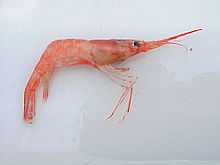Eating live seafood
The practice of eating live seafood, such as fish, crab, oysters, baby shrimp, or baby octopus, is widespread. In India, the government provides support for an annual fish medicine festival in Hyderabad, where asthma patients are given a live sardine to eat which is supposed to cure their asthma.[1] Infection by the fish tapeworm Diphyllobothrium latum is seen in countries where people eat raw or undercooked fish, such as some countries in Asia, Eastern Europe, Scandinavia, Africa, and North and South America.[2]
In London, Louis Cole makes a living eating live food, including live seafood, and is widely viewed on his YouTube channel.[3][4] The Guardian commented on the ethical issues raised by the behaviour of Coles that: "It seems objectively less cruel to kill a scorpion instantly than to rear chickens in battery cages or pigs in the most miserable pork farms.[3]
The view that live oysters are acceptable to eat, even by strict ethical criteria, has notably been propounded in the seminal 1975 text Animal Liberation, by philosopher Peter Singer. However, subsequent editions have reversed this position (advocating against eating live oysters). Singer has stated that he has "gone back and forth on this over the years", and as of 2010 states that "while you could give them the benefit of the doubt, you could also say that unless some new evidence of a capacity for pain emerges, the doubt is so slight that there is no good reason for avoiding eating sustainably produced oysters".[5]
Live seafood dishes
| Location |
Name |
Image |
Description |
|---|
| China |
Drunken shrimp |
 |
Drunken shrimp is a popular dish in parts of China. It is based on fresh-water shrimp that are placed in a strong liquor, baijiu, and then eaten, often while they are alive. Modified recipes are used in different parts of China. For example, the drunken shrimp can be cooked in boiling water instead of serving them while they are still live. In other recipes, the shrimp are boiled first and then marinated in alcohol.[6] |
| Ying Yang fish |
|
Ying Yang fish, or dead-and-alive fish, originated in Taiwan, and consists of a whole live fish which has had some of its flesh deep-fried in such a way that the fish seems to remain alive after the frying process. Some chefs say they prepare the fish this way to demonstrate it freshness to the customer. The practice has been criticized,[7][8] and there was further critical reaction after a video showing diners eating a live fish had widespread exposure on the internet.[9][10][11] Preparation of this dish is now prohibited in Taiwan and illegal in Australia and Germany. However, the practice continues in China. |
| Japan |
Ikizukuri |
 |
Ikizukuri, lit. "prepared alive", is the preparation of sashimi made from live seafood. Fish is usually used, but sometimes octopus, shrimp and lobster are used instead.[12] The restaurant may have one or several tanks of live sea animals for a customer to choose from. The practice is controversial, and ikizukuri is outlawed in Australia and Germany.[13] |
| Odori ebi |
 |
Odori ebi, lit. "dancing shrimp", is a sashimi delicacy in Japan. It includes live baby pink shrimp wriggling their legs and waving their antenna as they are eaten. The meal is prepared rapidly and quickly served to ensure the shrimp are still alive. In a parallel to the drunken shrimp above, dancing shrimp are usually dunked in sake.
Dancing shrimp are also eaten in Thailand, where they are known as Goong Ten, กุ้งเต้น. |
| Live lobster |
 |
|
| Korea |
Sannakji |
 |
Sannakji is a type of hoe, or raw dish, in Korea. It consists of live baby octopuses (nakji), either whole, or cut into small pieces and immediately served, usually with a light sesame oil seasoning. They are eaten while the nakji or pieces squirm on the plate. Octopus heads contain high levels of the toxic heavy metal cadmium.[14] |
| Widespread |
Live oyster |
 |
|
See also
References
External links







